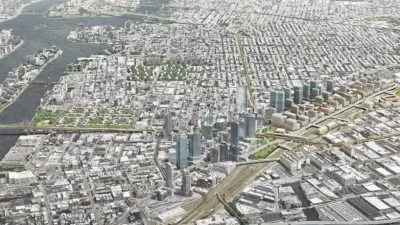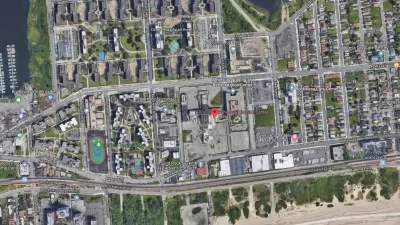It's known as the Iron Triangle, though some call the sewerless 13-block collection of auto junkyards just east of Shea Stadium an eyesore and disgrace. A controversial application of eminent domain is at the heart of the $3 billion makeover plan.
From NYT, July 8, 2007:
It is "an astonishingly ramshackle industrial shantytown, something out of "Mad Max," bereft of most city services. The unlit streets are blocked by 40-foot-long puddles of standing water, filling truck-length potholes that traffic must creep around. Since there are no sidewalks, pedestrians share the street with cars; nor are there sewer lines for toilets, and most of the buildings are jerry-rigged structures of corrugated aluminum."
From Queens Chronicle:
"In an agonizing vote that took 5 1/2 hours to reach, (Queens) Community Board 7 members voted 20-15 (on July 1) to approve the city's controversial Willets Point development plan.
The city wants to redevelop the 60-acre area now occupied by car junkyards and businesses into a mixed-use area including 5,500 housing units... There are no sewers or sidewalks there now, continuing to draw the ire of business owners, who say that if the city put in those improvements, the area would evolve on its own.
Seventy speakers were scheduled to give their opinion on the project. They were equally divided among those who supported the plan - union leaders and environmentalists - and those who opposed it - workers and owners plus proponents of more affordable housing.
The issue of the city using eminent domain to take properties did not sit well with many community board members and certainly not with the business owners. Although the city has said it is working in good faith to find new locations for the 250 businesses in Willets Point, so far only two landowners have agreed to sell."
"Without a complete cleanup of the soils beneath Willets Point, all our efforts at cleaning up the surrounding waterways will come to naught," said one advocate for redevelopment.
From NYT (May 29, 2005):
The Iron Triangle "was supposed to be part of Flushing Meadows, home of the Mets and the U.S. Open tennis tournament and the site of two world's fairs. But because of the machinations of the master builder Robert Moses and the oratorical skills of a young lawyer named Mario M. Cuomo, a strategically located part of Queens one-tenth the size of Central Park became a junkyard, a veritable wall of concrete, oil and scrap metal that prevents development along the Flushing waterfront.
On a clear day, the stretch of car repair shops, scrap metal depots and waste treatment plants resembles nothing so much as a scene from "The Road Warrior." The thoroughfares are blistered with holes like the surface of the moon, and the wind churns up clouds of dust that blow through 70 acres of scrap metal, mounds of contaminated earth and abandoned cars of every description."
FULL STORY: C.B. 7 Approves Willets Pt. Plan

Alabama: Trump Terminates Settlements for Black Communities Harmed By Raw Sewage
Trump deemed the landmark civil rights agreement “illegal DEI and environmental justice policy.”

Planetizen Federal Action Tracker
A weekly monitor of how Trump’s orders and actions are impacting planners and planning in America.

The 120 Year Old Tiny Home Villages That Sheltered San Francisco’s Earthquake Refugees
More than a century ago, San Francisco mobilized to house thousands of residents displaced by the 1906 earthquake. Could their strategy offer a model for the present?

Ken Jennings Launches Transit Web Series
The Jeopardy champ wants you to ride public transit.

BLM To Rescind Public Lands Rule
The change will downgrade conservation, once again putting federal land at risk for mining and other extractive uses.

Indy Neighborhood Group Builds Temporary Multi-Use Path
Community members, aided in part by funding from the city, repurposed a vehicle lane to create a protected bike and pedestrian path for the summer season.
Urban Design for Planners 1: Software Tools
This six-course series explores essential urban design concepts using open source software and equips planners with the tools they need to participate fully in the urban design process.
Planning for Universal Design
Learn the tools for implementing Universal Design in planning regulations.
Clanton & Associates, Inc.
Jessamine County Fiscal Court
Institute for Housing and Urban Development Studies (IHS)
City of Grandview
Harvard GSD Executive Education
Toledo-Lucas County Plan Commissions
Salt Lake City
NYU Wagner Graduate School of Public Service




























